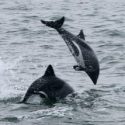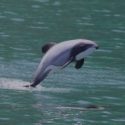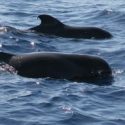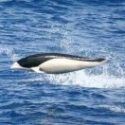Welcome to the Family!
The Delphinidae family is a rich and diverse group of species. There are currently 39 recognized species of dolphin within Delphinidae. This is one of the few places you can find a complete list of these species.
Eventually each of these species will have a page with more details.
Photo by Mark Gunn – CC Attribution
Subfamily: Delphinidae
Delphinus delphis
Common Dolphin
Found in many parts of the oceans around the world, the common dolphin is a colorful species that often travel in pods of thousands of individuals. There has not been a lot of research around this species, partly because of the difficulty in tracking an individual dolphin among a thousand others.

Image • CC BY-SA 4.0 Delphinidae.org
Delphinus delphis
Short Beaked Common Dolphini
Short Beaked Common Dolphins inhabit both the Atlantic and Pacific oceans with populations reaching throughout the Mediterranean sea as well.
There are two subspecies: Delphinus delphis delphis and Delphinus delphis ponticus.

Photo • Public Domain
Delphinus capensis
Long Beaked Common Dolphin
Found in the southern pacific and indian oceans, as well as parts of the pacific ocearn, the Long Beacked Common Dolphin also has two identified subspecies: Delphinus capensis capensis and Delphinus capensis tropicalis.
Cephalorhynchus
Piebald Dolphins
Small, usually black and white dolphins. Each currently has a small population and are near threatened or endangered.
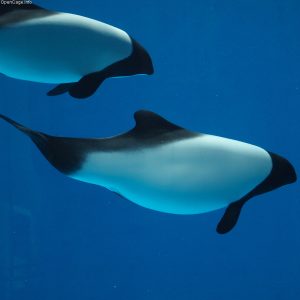
Photo by opencage.info – CC Attribution Share Alike
Cephalorhynchus commersonii
Commerson’s Dolphin
Found off the cost of the southern tip of South America, the Commerson’s dolphin is a small white dolphin with black accents.

Cephalorhynchus eutropia
Chilean Dolphin
Found only on the coast of Chile, the Chilean dolphin has a “near threatened” status with some reports indicating only about 5,000 individuals remain.
Cephalorhynchus heavisidii
Heaviside’s Dolphin
This small dolphin with orca colors can be found on the western coastline of southern Africa.
Cephalorhynchus hectori
Hector’s Dolphin
This is a small endangered dolphin found around New Zealand.
Feresa
Pygmy Killer Whales
There is only one species in this genus, the Feresa attenuata.

Image • CC BY-SA 4.0 Delphinidae.org
Feresa attenuata
Pygmy Killer Whale
This dolphin features a dark color with a short snout. It is rarely seen, but has been spotted in a huge range spanning the atlantic, pacific and indian oceans.
Globicephala
Pilot Whales
This large dolphin has not been the target of much scientific study, so there is a lot we don’t know about it.
Globicephala macrorhynchus
Short-finned Pilot Whale
Inhabiting both coastal waters and the deep ocean, in the atlantic, pacific and indian oceans, this dolphin is very similar to it’s relative the long-finned pilot whale.
Globicephala melas
Long-finned Pilot Whale
Named for it’s long pectoral fins, this dolphin can be found in the colder waters of the north atlantic and the northern parts of the antarctic.
Grampus
Grampus
This deep water genus is little studied. So much in fact that the “common” name is simply the scientific name.
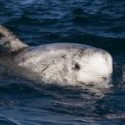
Photo – Amila Tennakoon – CC Attribution
Grampus griseus
Risso’s Dolphin
Discovered by Antoine Risso, this dolphin accumulates scars throughout it’s life that eventually nearly cover it’s entire body.
Lagenodelphis
Borneau dolphins
When a skull was discovered on a beach in Sarawak, Borneo, an island in southeast Asia, it was brought to the British museum, where it was left unstudied until Francis Fraser examined it, after whom the only species of this genus is named.

Lagenodelphis hosei
Fraser’s Dolphin
This small stocky dolphin is found in the warm waters of the Atlantic, pacific and Indian oceans.
Lagenorhynchus
White Sided Dolphins / White Beaked Dolphins
It’s scientific name means “bottle beak”.
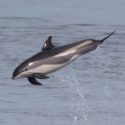
Photo • CC Share-Alike – Wikipedia
Lagenorhynchus acutus
Atlantic White-sided Dolphin
This dolphin lives in the far north atlantic.

Lagenorhynchus albirostris
White-beaked Dolphin
This dolphin lives in the far north atlantic.

Photo • FDrummondH – CC Share-Alike
Lagenorhynchus australis
Peale’s Dolphin
This dolphin lives along the coasts of the southern tip of South America.
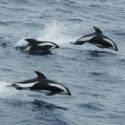
Photo • CC Share-Alike – Wikipedia
Lagenorhynchus cruciger
Hourglass Dolphin
This cute, small dolphin can be found in the antarctic.

Photo – Ruth Hartnup – CC Attribution
Lagenorhynchus obliquidens
Pacific White-sided Dolphin
This dolphin lives in the far north pacific.
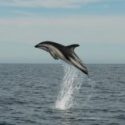
Photo • Public Domain
Lagenorhynchus obscurus
Dusky Dolphin
This smaller dolphin lives along the coasts of the cooler waters of the southern hemisphere.
Lissodelphis
Right-Whale Dolphins
These small dolphins have no dorsal fin.
Lissodelphis borealis
Northern Right-Whale Dolphin
The Northern Right Whale Dolphin is found only in the northern Pacific ocean. This could be why it was discovered 44 years after the Southern Right Whale Dolphin.
Lissodelphis peronii
Southern Right-Whale Dolphin
Noticeable by their bright white underside, these graceful dolphins inhabit the colder waters of the antarctic ocean.
Orcaella
Snubfin Dolphins
Most closely related to the Orca, these dolphins look a lot like Beluga whales.
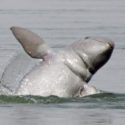
Photo – Dan Koehl – CC Attribution
Orcaella brevirostris
Irrawaddy Dolphin
This unique Beluga-like dolphin can be found along the coasts and in the rivers of southeast Asia. It features a u shaped blow hole that is not centered on it’s back, but is just to the left, and opens toward the front.

Orcaella heinsohni
Australian Snubfin Dolphin
Differentiated by a subdued tri-color skin among other minor differences, this dolphin makes the shores of Australia it’s home.
Orcinus
Killer Whales
Orcinus is the genus of the famous Orca. Although there is variation within the species, only a single species is known in Orcinus.
Orcinus orca
Orca / Killer Whale
Spanning every ocean in the world, the orca is known in nearly every part of the world. It is difficult to track an orca pod due to the large distances and the lack of fixed migration patterns that they take, so little is known about just how far they can travel.
Peponocephala
Melon-Headed Whales
Named for it’s melon-shaped head, only one species is known to exist in this genus.

Photo • NOAA Photo Library – CC Attribution
Peponocephala electra
Melon-Headed Whale
Usually found in tropical waters beyond the continental shelf, this species is known to be a very fast swimmer.
Pseudorca
False Killer Whales
False Killer Whales are often mistaken for other species due to their wide range.

Photo • NOAA Photo Library – CC Attribution
Pseudorca crassidens
False Killer Whale
Despite is huge range, encompassing the Atlantic, Pacific and Indian oceans, the False Killer Whale is Near Threatened on the Red List.
Sotalia
Tucuxi
These dolphins are found along the coasts of north-eastern South America, and in the Amazon river.

Photo – Archilider [CC BY-SA 4.0]
Sotalia fluviatilis
Tucuxi / Gray Dolphin
Originally considered the only species of Sotalia, the Gray Dolphin is likely so called because despite it’s pinkish belly, it is very gray compared with the Amazon River Dolphin (which is technically outside of the Delphinidae family).
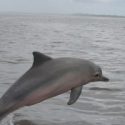
Photo • Jan Willem Broekema – CC BY-SA 2.0
Sotalia guianensis
Guiana Dolphin / Estuarine Dolphin
Thought to inhabit the same range as the Tucuxi, it seems not to exhibit the pink color on it’s belly, and more closely resembles the bottlenose dolphin.
Sousa
Humpbacked Dolphins
These coastal dolphins get their name from a hump shape at the front of their dorsal fin. Very little information is currently published about theses species.

Sousa chinensis
Indo-Pacific Humpback Dolphin
When found near the coasts of China, this species is referred to as the Chinese White Dolphin. It’s range extends throughout Indonesia and northern Australia.

Sousa plumbea
Indian Humpback Dolphin
Appearing more like a Bottlenose Dolphin except for the appearance of their dorsal fin hump, the Indian Humpback Dolphin inhabits the coastal waters of India and eastern Africa.

Sousa teuszii
Atlantic Humpback Dolphin
Even less seems to be known about this critically endangered species than it’s relatives within Sousa. It is found along parts of the western coast of Africa.

Sousa sahulensis
Australian Humpback Dolphin
Compared to it’s relatives, the Australian Humpback Dolphin features less of a dorsal hump, and has a shorter dorsal fin. It also has a line along it’s side where it’s darker back is separated from it’s lighter belly.
Stenella
Spotted, Spinners, and Striped Dolphins
Likely the most popular species, behind only the Bottlenose and the Orca.
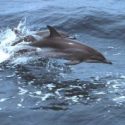
Photo • Public Domain
Stenella clymene
Short-Snouted Spinner Dolphin
This small dolphin features distinct facial markings. It is found only in the tropics of the Atlantic ocean.
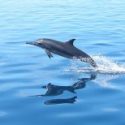
Photo • Alexia Pihier – CC BY-SA 4.0
Stenella longirostris
Long-Snouted Spinner Dolphin
These spinners are found in warm waters around the world.
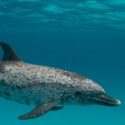
Photo • Amila Tennakoon – CC BY-SA 2.0
Stenella frontalis
Atlantic Spotted Dolphin
Spotted dolphins are born without spots, but over time, more and more spots appear. As such, the number of spots can indicate the age of the individual.
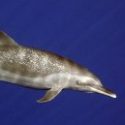
Photo – NOAA [CC BY-SA 3.0]
Stenella attenuata
Pantropical Spotted Dolphin
With at least two subspecies (attenuata and graffmani), the Pantropical Spotted Dolphin’s range covers the tropical and subtropical regions of the Atlantic, Pacific and Indian oceans.

Photo • Amila Tennakoon – CC BY-SA 2.0
Stenella coeruleoalba
Striped Dolphin
Named for a dominant stripe in color along it’s side, the Striped Dolphin has an incredibly large distribution, from Greenland to New Zealand, it can be found nearly anywhere with the exception of the west coast of South America.
Steno
Rough-Toothed Dolphins
This unique genus has only one species.

Steno bredanensis
Rough-Toothed Dolphin
With an incredibly large distribution, this dolphin has been reported in virtually every ocean of the world. Despite this, it is thought to have a small total population, and little is known about it’s population.
Tursiops
Bottlenose Dolphins
The adored Bottlenose Dolphin is an icon of the dolphin world.

Photo • Mike Prince – CC BY-SA 2.0
Tursiops aduncus
Indo-Pacific Bottlenose Dolphin
This dolphin differs from truncatus in that it is smaller, and features spots on it’s underside.
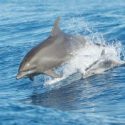
Photo – Brandon Trentler [CC BY-SA 2.0]
Tursiops truncatus
Bottlenose Dolphin
With several sub-species, the Bottlenose Dolphin has one of the largest distributions of any species within Delphinidae. This is also the most common species featured in dolphinariums.
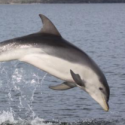
Photo • Charlton-Robb K – CC BY 2.5
Tursiops australis
Burrunan Dolphin
Recognized in 2011, this bottlenose dolphin is in-between aduncus and truncatus in size. Only two stocks have been identified, both on the coasts of Australia.
